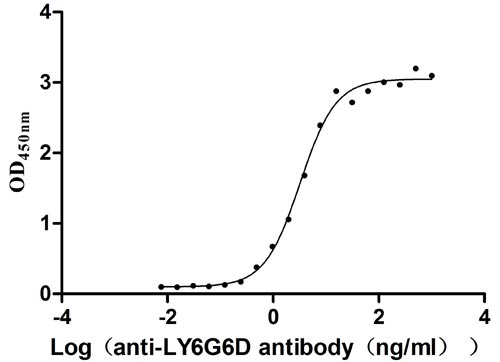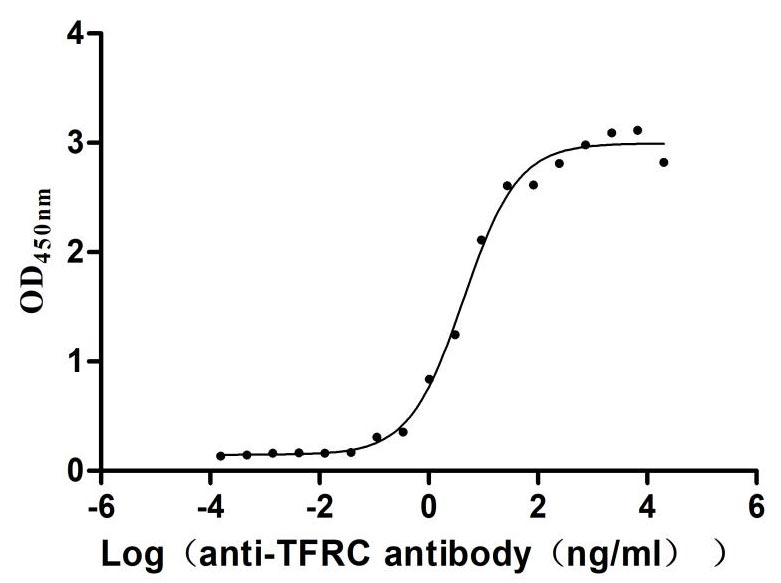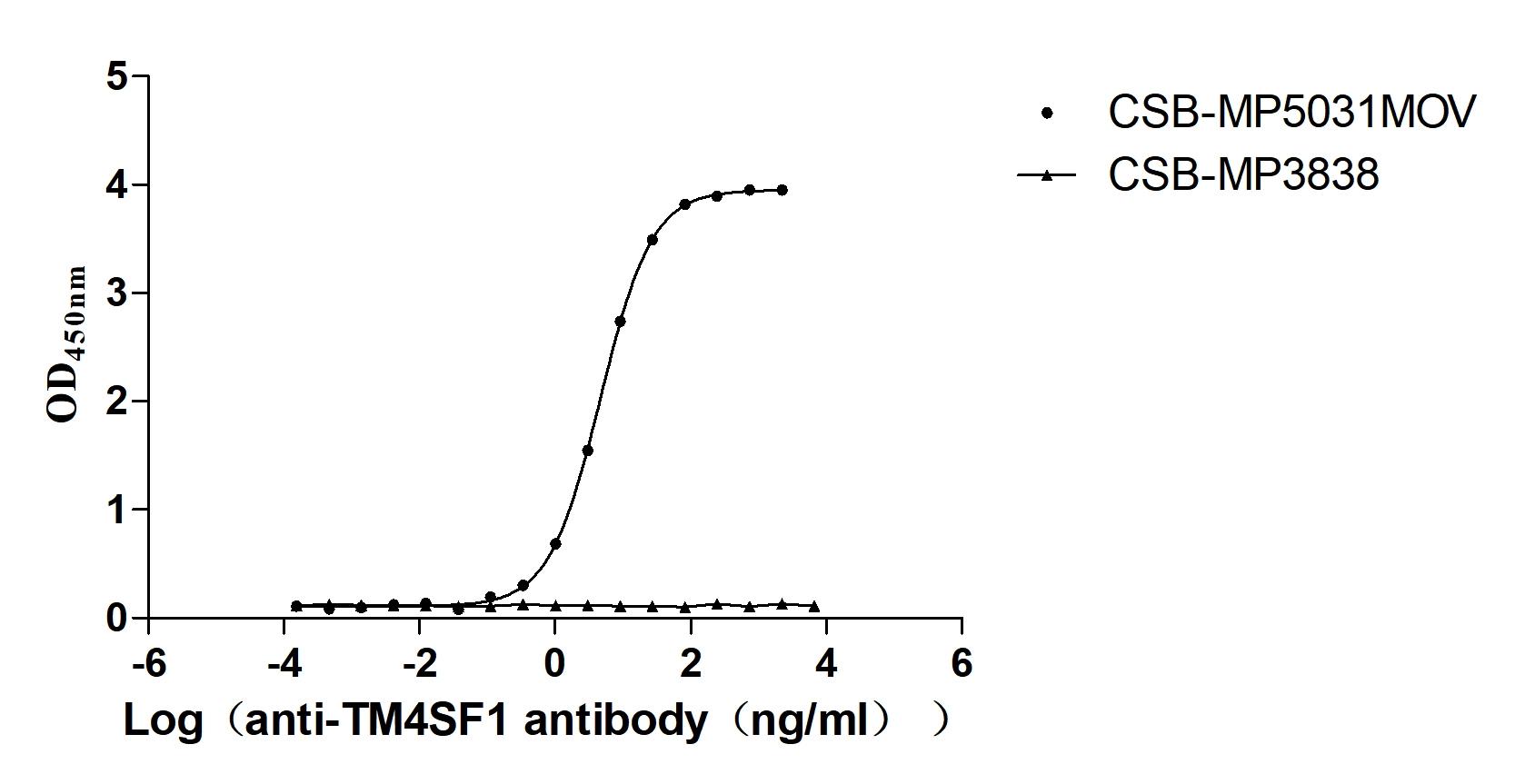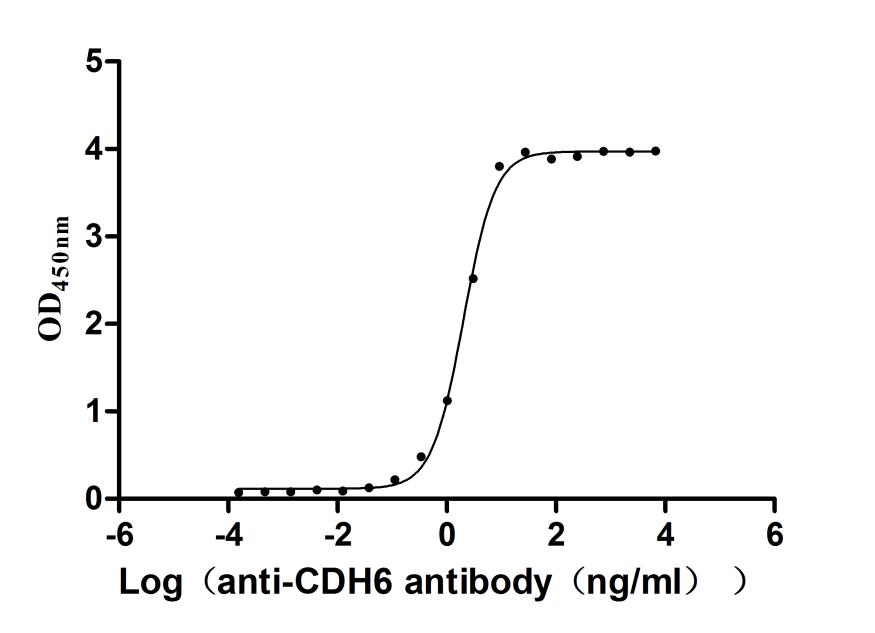Recombinant Mouse High affinity nerve growth factor receptor (Ntrk1), partial
-
货号:CSB-YP667566MO
-
规格:
-
来源:Yeast
-
其他:
-
货号:CSB-EP667566MO
-
规格:
-
来源:E.coli
-
其他:
-
货号:CSB-EP667566MO-B
-
规格:
-
来源:E.coli
-
共轭:Avi-tag Biotinylated
E. coli biotin ligase (BirA) is highly specific in covalently attaching biotin to the 15 amino acid AviTag peptide. This recombinant protein was biotinylated in vivo by AviTag-BirA technology, which method is BriA catalyzes amide linkage between the biotin and the specific lysine of the AviTag.
-
其他:
-
货号:CSB-BP667566MO
-
规格:
-
来源:Baculovirus
-
其他:
-
货号:CSB-MP667566MO
-
规格:
-
来源:Mammalian cell
-
其他:
产品详情
-
纯度:>85% (SDS-PAGE)
-
基因名:
-
Uniprot No.:
-
别名:Ntrk1; High affinity nerve growth factor receptor; EC 2.7.10.1; Neurotrophic tyrosine kinase receptor type 1
-
种属:Mus musculus (Mouse)
-
蛋白长度:Partial
-
蛋白标签:Tag type will be determined during the manufacturing process.
The tag type will be determined during production process. If you have specified tag type, please tell us and we will develop the specified tag preferentially. -
产品提供形式:Lyophilized powder
Note: We will preferentially ship the format that we have in stock, however, if you have any special requirement for the format, please remark your requirement when placing the order, we will prepare according to your demand. -
复溶:We recommend that this vial be briefly centrifuged prior to opening to bring the contents to the bottom. Please reconstitute protein in deionized sterile water to a concentration of 0.1-1.0 mg/mL.We recommend to add 5-50% of glycerol (final concentration) and aliquot for long-term storage at -20℃/-80℃. Our default final concentration of glycerol is 50%. Customers could use it as reference.
-
储存条件:Store at -20°C/-80°C upon receipt, aliquoting is necessary for mutiple use. Avoid repeated freeze-thaw cycles.
-
保质期:The shelf life is related to many factors, storage state, buffer ingredients, storage temperature and the stability of the protein itself.
Generally, the shelf life of liquid form is 6 months at -20°C/-80°C. The shelf life of lyophilized form is 12 months at -20°C/-80°C. -
货期:Delivery time may differ from different purchasing way or location, please kindly consult your local distributors for specific delivery time.Note: All of our proteins are default shipped with normal blue ice packs, if you request to ship with dry ice, please communicate with us in advance and extra fees will be charged.
-
注意事项:Repeated freezing and thawing is not recommended. Store working aliquots at 4°C for up to one week.
-
Datasheet :Please contact us to get it.
靶点详情
-
功能:Receptor tyrosine kinase involved in the development and the maturation of the central and peripheral nervous systems through regulation of proliferation, differentiation and survival of sympathetic and nervous neurons. High affinity receptor for NGF which is its primary ligand, it can also bind and be activated by NTF3/neurotrophin-3. However, NTF3 only supports axonal extension through NTRK1 but has no effect on neuron survival. Upon dimeric NGF ligand-binding, undergoes homodimerization, autophosphorylation and activation. Recruits, phosphorylates and/or activates several downstream effectors including SHC1, FRS2, SH2B1, SH2B2 and PLCG1 that regulate distinct overlapping signaling cascades driving cell survival and differentiation. Through SHC1 and FRS2 activates a GRB2-Ras-MAPK cascade that regulates cell differentiation and survival. Through PLCG1 controls NF-Kappa-B activation and the transcription of genes involved in cell survival. Through SHC1 and SH2B1 controls a Ras-PI3 kinase-AKT1 signaling cascade that is also regulating survival. In absence of ligand and activation, may promote cell death, making the survival of neurons dependent on trophic factors.
-
基因功能参考文献:
- intrachromosomal deletion generating a fusion between BCAN and NTRK1 drives the formation of aggressive high-grade gliomas and confers sensitivity to entrectinib PMID: 28695888
- System xC(-)-mediated TrkA activation therefore presents a promising target for therapeutic intervention in cancer pain treatment. PMID: 29761734
- these findings demonstrate that communication between osteoblasts and sensory nerves through NGF-TrkA signaling is essential for load-induced bone formation in mice. PMID: 28416686
- Imipramine protected bupivacaine-induced neurotoxicity in DRG, likely via the co-activation of TrkA and TrkB signaling pathways. PMID: 28398601
- Foretinib protected neurons by suppressing both known degenerative pathways and a new pathway involving unliganded TrkA and transcriptional regulation of the proapoptotic BH3 family members. PMID: 28877995
- retrograde signaling by target-derived nerve growth factor (NGF) is necessary for soma-to-axon transcytosis of TrkA receptors in sympathetic neurons. PMID: 28919207
- These findings suggest that by interacting with PlexA4, TrkA plays a crucial role in redirecting local Sema3A signaling to retrograde axonal transport, thereby regulating dendritic GluA2 localization and patterning. PMID: 26945060
- proposal that KIF1A is essential for the survival and function of sensory neurons because of the TrkA transport and its synergistic support of the NGF/TrkA/PI3K signaling pathway PMID: 27263974
- As a result, overexpression of PTP-MEG2 down-regulates NGF/TrkA signaling and blocks neurite outgrowth and differentiation PMID: 27655914
- TrkA misfolding and aggregation induced by some Insensitivity to Pain with Anhidrosis mutations disrupt the autophagy homeostasis causing neurodegeneration. PMID: 27551041
- Dimeric dipeptide mimetics of the nerve growth factor Loop 4 and Loop 1 activate TRKA with different patterns of intracellular signal transduction. PMID: 26642930
- Data show that lysophosphatidic acid (LPA) induces phosphorylation of trkA receptor (TrkA) through lysophosphatidic acid receptor 1 (LPA1) binding to TrkA PMID: 26597701
- adult homozygous TrkAC knock-in mice displayed severe deficits in acute and tissue injury-induced pain, representing the first viable adult Trk mouse mutant with a pain phenotype PMID: 24516396
- SOCS2 immunoprecipitates with TrkA and a juxtamembrane motif of TrkA is required for this interaction. Over-expression of SOCS2 in PC12 Tet-On cells increased total and surface TrkA expression. PMID: 24484474
- the ubiquitination of the TrkA neurotrophin receptor plays a critical role in NGF-mediated functions, such as neuronal survival and sensitivity to pain. PMID: 24760869
- These data suggest that ubiquitination is a mechanism used in nociceptive neurons to regulate TrkA level and function. PMID: 24623787
- NGF support the survival of only a subset of basal forebrain cholinergic neuron during brain development. PMID: 23100411
- Clostridium perfringens alpha-toxin recognizes the GM1a-TrkA complex. PMID: 22847002
- Down-modulation of STK25, but not STK24, rescued medulloblastoma cells from NGF-induced TrkA-dependent cell death, suggesting that STK25 is part of the death-signaling pathway initiated by TrkA and CCM2. PMID: 22782892
- findings suggest the implication of Trk A and Src in ERbeta mediated brain functions and related disorders during aging PMID: 22011838
- This study demonistrated that demonstrated that TrkA loss results in cholinergic BF dysfunction and cognitive decline. PMID: 22442072
- Cux2 is expressed and may participate in development of a specific subtype of myelinated TrkA(+) nociceptors. PMID: 21945863
- Both NTRK1 and NTRK2 receptors are necessary for the timely assembly of primordial follicles and for sustaining early follicular development. PMID: 19357131
- PxIxIT-containing dynamin1 isoforms colocalize with surface TrkA receptors, and their phosphoregulation is selectively required for NGF-dependent TrkA internalization and axon growth in sympathetic neurons. PMID: 21689596
- mouse NK cells express the NGF receptor TrkA and this expression is dynamically regulated PMID: 21152021
- the earlier that the blockade of TrkA occurs, the more effective the control of cancer pain and the tumor-induced remodeling of sensory nerve fibers PMID: 21138586
- Neuroprotective effect of low-molecular peptide mimetic (GK-2) of nerve growth factor is related to activated synthesis of heat shock proteins (hsp32 and hsp70) and increased phosphorylation of TrkA receptor PMID: 21395008
- overexpressed on the bronchoalveolar lavage fluid cells of asthmatic mice PMID: 20934630
- STAT3 has a role in in vitro transformation triggered by TRK oncogenes PMID: 20209132
- TrkA and TrkC instruct developing neurons to die, both in vitro and in vivo. By contrast, TrkB, a closely related receptor primarily expressed in the central nervous system, does not. PMID: 20811452
- Data show that down-regulation of TrkA also occurs in the cerebellum of SCA17 transgenic mice prior to Purkinje cell degeneration. PMID: 19643914
- Distinctive features of Trk neurotrophin receptor transactivation by G protein-coupled receptors PMID: 11750876
- ShcB and ShcC bind the Trk receptors in a phosphotyrosine-dependent manner via their N-terminal phosphotyrosine binding domain PMID: 12006576
- both trkA and trkC neurotropin receptors influence germ cell numbers during testis development and events such as seminiferous cord formation PMID: 12021070
- role in developing Merkel innervation PMID: 12117822
- trkA detected in lung homogenate, and in capillary cells, but not in alveolar macrophages; a previously unknown trafficking signal occurs through neurotrophins in peripheral lung PMID: 12122447
- TrkA is activated by gangliosides inducing the release of neurotrophins, but less potently than TrkC PMID: 12388556
- Trk A was not observed in stria vascularis, hair cell stereocilia, nor in the Trk B- and Trk C-rich cerebellum. This distribution pattern of Trk A suggests that its ligand, NGF, exerts significant trophic effects in the rodent inner ear. PMID: 14698082
- Stress and substance P injection significantly increased the abortion rate and up-regulated decidual NGF and TrkA expression compared with the control PMID: 14725570
- Related neurotrophins NGF and NT-3, acting through a common receptor, TrkA, are required for sequential stages of sympathetic axon growth and, thus, innervation of target fields. PMID: 15260993
- lack of this protein provokes an altered organogenesis of the thymus. PMID: 15372954
- mutants appear normal, have elevated serum levels of certain immunoglobulin classes and accumulate B1 cells with aging PMID: 15459109
- mRNA-TrkA is over-expressed in the subventricular zone and hippocampus of dominant and subordinate mice. PMID: 15639186
- Data demonstrate that Kalirin binds to and colocalizes with the TrkA neurotrophin receptor in neurons. PMID: 15923627
- Klf7 gene ablation reduces TrkA expression in sensory neurons due to effect on cell death PMID: 15937222
- identify Src family kinases as mediating nucleotide-enhanced neurotrophin-dependent neuronal differentiation and thus, as a key convergence point for interaction between TrkA receptor tyrosine kinases and P2Y(2) G-protein-coupled receptors PMID: 16842754
- Cooperation between Brn3a and Klf7 is required for endogenous TrkA gene expression and the survival of nociceptive sensory neurons. PMID: 17011544
- Results suggest that DeltaNp73 negatively regulates NGF-mediated neuronal differentiation by transrepressing TrkA. PMID: 17353261
- deltaTrkA has potent and unique transforming properties in leukemogenesis PMID: 17673903
- Semaphorin3A regulates axon growth independently of growth cone repulsion via modulation of TrkA signaling. PMID: 18096366
显示更多
收起更多
-
亚细胞定位:Cell membrane; Single-pass type I membrane protein. Early endosome membrane; Single-pass type I membrane protein. Late endosome membrane; Single-pass type I membrane protein. Recycling endosome membrane; Single-pass type I membrane protein.
-
蛋白家族:Protein kinase superfamily, Tyr protein kinase family, Insulin receptor subfamily
-
数据库链接:
KEGG: mmu:18211
STRING: 10090.ENSMUSP00000029712
UniGene: Mm.80682
Most popular with customers
-
Recombinant Macaca fascicularis Angiotensin-converting enzyme (ACE2), partial (Active)
Express system: Mammalian cell
Species: Macaca fascicularis (Crab-eating macaque) (Cynomolgus monkey)
-
Recombinant Human Semaphorin-4D (SEMA4D), partial (Active)
Express system: Mammalian cell
Species: Homo sapiens (Human)
-
Recombinant Human Lymphocyte antigen 6 complex locus protein G6d (LY6G6D) (Active)
Express system: Yeast
Species: Homo sapiens (Human)
-
Recombinant Human Transferrin receptor protein 1 (TFRC), partial (Active)
Express system: Mammalian cell
Species: Homo sapiens (Human)
-
Recombinant Macaca fascicularis Transmembrane 4 L6 family member 1 (TM4SF1)-VLPs (Active)
Express system: Mammalian cell
Species: Macaca fascicularis (Crab-eating macaque) (Cynomolgus monkey)
-
Recombinant Human Interleukin-1 receptor accessory protein (IL1RAP), partial (Active)
Express system: Mammalian cell
Species: Homo sapiens (Human)
-
Recombinant Mouse Cadherin-6(Cdh6),partial (Active)
Express system: Mammalian cell
Species: Mus musculus (Mouse)



















